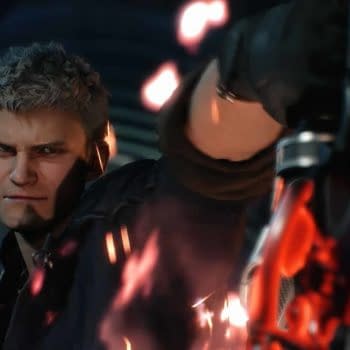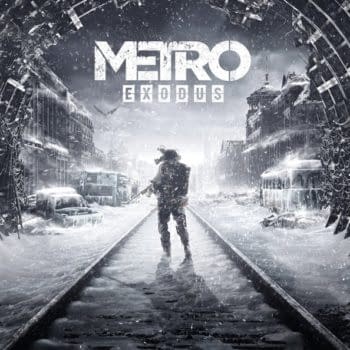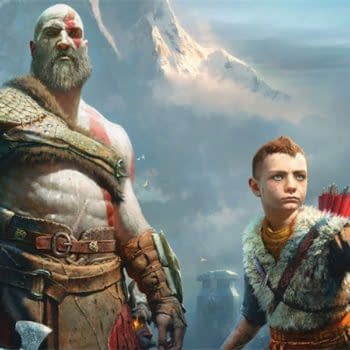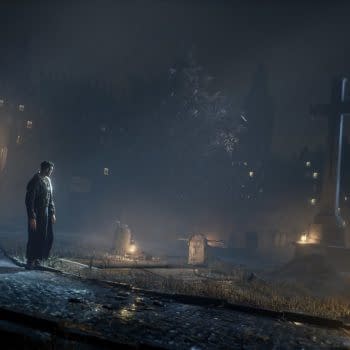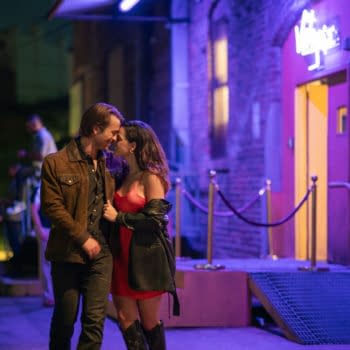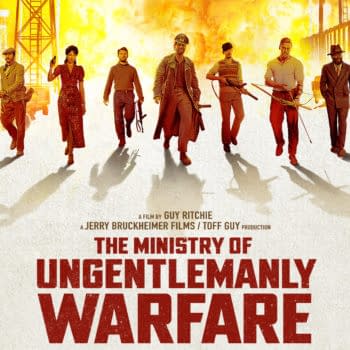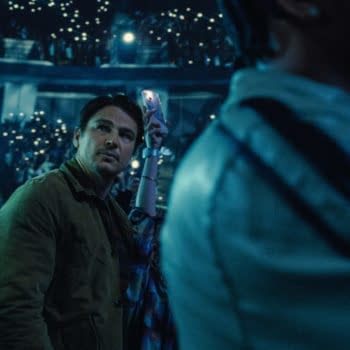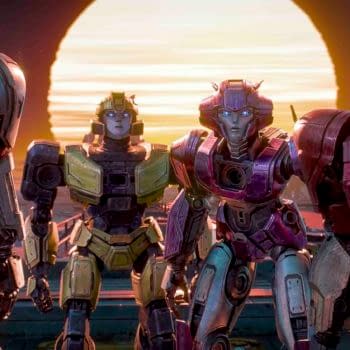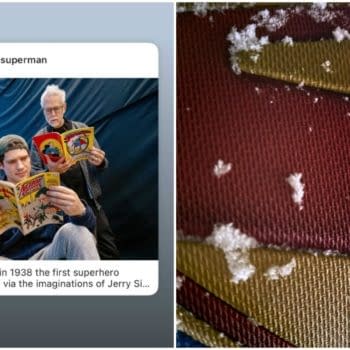Posted in: Movies, Video Games | Tagged: disney, entertainment, film, jon favreau, The Jungle Book
Interview: Jon Favreau Speaks With Us About The Jungle Book, Making Animals Talk And Getting People Into The Cinema
The Jungle Book is really quite good. It's endlessly gorgeous and tells a fable like story, updating the now classic animated movie into an effects laden family film. There is so much that shouldn't have worked about the movie, such as having photo realistic animals talking and singing, as that's something that has barely ever looked great, but it blends it all to make a beautiful adventure well worth your time.
A lot of that is a credit to the work of Jon Favreau. He sells the hell out of the movie, and for my money, he has really highlighted how versatile he is with the Jungle Book, coming off Iron Man and Chef respectively.
I got to sit down with him yesterday, one to one, to talk about the movie too with lots to cover. From the photo realism, the technology used in the movie, the state of 3D, the songs and how you get Christopher Walken to play a Gigantopithecus.
So let's hop to it:
–
Patrick Dane: All right, first of all, loved the movie.
Jon Favreau: Thank you, that's nice to hear.
PD: It's very good. I wanted to start this though with 'why this story' and 'why right now'?
JF: I think part of it is from just a pragmatic business sense. Disney was feeling very good about how audiences were receiving their live-action adaptations of their classic animated films. I think that people thought that they were doing a good job. Critically I think they were well received, and it was also well received by audiences.
And in an age where it becomes harder and harder to figure out how to connect with an audience and get them to go to the theatre, in addition to the superhero movies and the science fiction movies, this particular subgenre seems to be something that people are curious about all around the world. That's always good because that gives them a certain confidence and the last thing you want to be dealing with is a studio that's afraid because, you know, you get restricted creatively when they're feeling kind of apprehensive.
But I think, for me personally, what was good about this moment is that the technology's available so you could tell the story in a different way than we could have done it at any time previous. Seeing films like Life of Pi, seeing films like Avatar, Gravity especially, even though it's not in the jungle, the techniques that they used were really interesting.
So that's what made me get excited, because I felt I could build a world. I love the old story, I've got kids, I like working with Disney, you know, I like working with them with Marvel, and so it felt like the right time; my kids were the right age and it felt like it was going to be something where I could learn a lot about how far you can push technology right now and create an experience that wasn't geared towards spectacle and fighting and explosions, which I had already done a lot of in previous films. Instead, it's about music and nature and laughter and humour in addition to making it thrilling and exciting, but not using any of the tools that I had available to me before.
PD: The choice to make it photorealistic, why did you stick there? Because obviously, most people, when they think of the Jungle Book it's that stylised animated thing. Why did you go with animals that look more or less like their real-life counterparts?
JF: I think part of that was because Disney's initial pitch to me was that we wanted to do something closer to the Rudyard Kipling than the animated version. I felt very connected to that version because I grew up with it, and so I was constantly trying to figure out ways to weave elements of the old one back into it, because I think there's an expectation when you're saying 'Disney's Jungle Book' that there's going to be aspects of it that it shares.
And certainly from working with Marvel, you know, I was always rewarded for keeping the fans in mind and if you can work it in and not diminish the story in its purest form then I think you can incorporate a lot of that stuff in it and it benefits the film.
PD: Yeah, even more specifically on that, like one thing that I think it does really well, which has not really been done that great in previous films, is having animals speak when they're not anatomically built to form words with their mouth.
JF: We tried to limit the way that they moved their mouths to fit in, the phonemes should match their anatomy, so you should get them to move their mouth in ways that they can. And then there's animals like snakes which can really move their mouths in ways that, you know, they have tremendous… their mouths actually have a lot of plasticity, but if you made their mouths move in the way that they could, you're not used to seeing it, so that would have felt weird too if they're articulated too much.
And so we kind of took our lead from Babe where they used real animals for the most part or practical rigs, added a little bit of CG mouth movement. In this case we did the entire animal CG but we tried to limit the movement of the animal to what they would normally do in reality and then the mouths would be moving on top of it.
But that was a, I mean for about two years we were worried if we were going to pull that off. It felt that was the biggest challenge of this movie really was to get that part right, because if you get the talking animals wrong the whole thing goes down the toilet.
PD: Yeah. And you talked about tech earlier. For you, as a director, as a storyteller, do you find using tech intrusive to your story or…?
JF: No.
PD: Was that one of the big draws for you then?
JF: It was one of the big draws, because I've really held back on jumping into CG; I've always used the minimum amount. And then through Iron Man I became more comfortable with it, because, you know, at the time hard surfaces were something that ILM did very well and I was fooled by which shots were real and which weren't, which is a great sign.
And then after seeing Life of Pi and then Planet of the Apes, I started to feel that maybe we're ready to show fur and animals. And any movie you're seeing in the theatre is about two years behind in the technology, so what was the next wave going to be?
And I met with MPC here in town, talked to Adam Valdez and, you know, we really got ambitious. We brought Weta to do the primates as well and we said 'If we're going to do it, let's go whole hog. Let's not fool ourselves and build big sets, let's build the minimum set, let's shoot it in a way where we can really shoot the actor as if he were an element in an effect shoot' kind of like Gravity did.
And so I completely embraced it on this one. I don't think it's for every film, but for this one and when it's required I think you'd better do the best job you can and better than anybody else.
PD: Especially with what you're building there, what do you think that spectacle adds to Hollywood movies nowadays that is important for an audience? Obviously when you talk to directors it's all about the story over spectacle, but how does spectacle fit into that storytelling?
JF: You have to deliver something that they can't get anywhere else, otherwise they will. If they can get it on their phone or their computer or their television, they're going to watch it that way. You have to create something that forces them to go to the movies, because I know, just personally, if I can wait, if I feel like I can wait a few weeks or a few months to see something, I will, to see it at home. I have a great television and I love watching things at home, and I think the content on television is fantastic right now.
So, you have to make these event movies that are going to drive people to the audience and take full advantage of the technology, and there's great tech coming out in theatres. There's Dolby Vision which is high dynamic range and 3D, the glasses go away, the contrast is beautiful, the blacks are so dark and the bright colours are so bright and it's just a beautiful image. And the new digital cameras are amazing too. And then we're also still doing beautiful work on film like Star Wars.
So I think we have to make a case as filmmakers for people to go through the extra trouble and expense to come out and see a movie. And you have to make it a better experience; you have to share with the next generation what we love so much about it, which is seeing something with a group of people as a communal experience.
And films that are made for young people are still doing well, because I think they understand that; they want to get out of the house, they want to be amongst each other. But it's so easy for us as we get a little bit more comfortable to just hide in our caves and watch our televisions in the dark, but we have to make it exciting for people to come out and see something together. And that's a combination of content and technology.
PD: I'm a big believer in 3D, and I actually spent some time learning how to create 3D, and 3D as a discussion point certainly has kind of gone away. Obviously Avatar was the whole big thing, but how do you go about working with it and what do you think the future of that technology is? Because I thought the 3D in the movie was quite beautiful actually.
JF: Thank you. I said 'If I'm going to do it in 3D,' which is what is part of what you're asked to do, and if you don't do it they'll convert it because it travels so well around the world. So, even if your vision is not 3D, it probably will end up as a 3D film if it's a budget of a certain size. So I said 'Let me, if I'm going to do it, let's do it in a way where it enhances the film.'
We captured it native using the Pace System which was developed by Jim Cameron for Avatar, we captured native, we composed the shots taking some cues actually from Disney who was an innovator in multiplane animation, where they create parallax by stacking the planes and moving them at different rates so it gives the illusion of 3D; that was 3D of its time and it is mind blowing. It must have been quite impactful when you saw it.
But Disney would move the camera a certain way, so we would look at shots from films like Bambi and Pinocchio to see how they treated their 3D and we treated ours very much the same way. So, on the one hand you're keeping it in the tradition of the Disney aesthetic, but you're also taking full advantage of this new technology.
PD: Obviously we talked about it being photorealistic and one of the things that is striking in the film is that you brought all the songs back. That's something that could have easily not gelled with how real you made the movie look.
JF: True, it's true.
PD: So, how did you go about integrating it and why was that choice made to make sure that those, classic songs were put back into it?
JF: It was something that I felt strongly about. Disney when I came on board wasn't even thinking that there would be music in it, but I also felt that if you didn't play Bare Necessities in Disney's Jungle Book, people would take it personally because there's expectation.
And, look, we're making a tonal shift as it is; it went from being a G-rated in the States, a G-rated children's musical to a PG-rated fairly intense Disney adventure for all ages you know? So I looked to those movies to draw inspiration for how to structure it, and most of those movies, they had a few songs but they weren't musicals.
All the way up to Lion King and the animated Tarzan, but they also have a world that's dangerous where characters would die, you know? You keep the violence off screen, but you can still make it heart pounding, you can still make people, little kids hide their eyes and I think that's part of the Disney tradition as well.
PD: Yeah, and especially as a director, how do you manage that level of threat, especially in a movie like this which is meant to be seen by everybody?
JF: Yeah, I mean, you check with the Ratings Board, you check with the Disney people, you keep in mind it's going to get photo-real towards the end of the process and that's going to make it a bit more intense. And, you know, you limit… you try not to show blood.
In Lion King they handle it very well; it's very ferocious when they're fighting and you see a few little red lines on their face. We couldn't even go that far with photorealism, but you're reminded that you could feel the intensity of those two characters going at it and it's still a movie for kids and it's still a movie with Hakuna Matata after his dad gets killed in a stampede. Those two things can exist in the same film in the Disney universe, so we tried to draw upon those traditions.
PD: Another thing that struck me as part of that threat is, or one of the things, and maybe not the entire purpose of the movie, but there's a lot in it about the power of nature being quite threatening. Especially when there's the mudslide…
JF: Yes.
PD: And, you know, obviously we're talking about tigers attacking Mowgli and stuff like, there is that undertone that nature is really pretty powerful.
JF: But in our version also I think that's different from 100 years ago with Kipling and 50 years ago with the animation, is that nature's delicate as well and when man comes into nature, nature loses. So I think Mowgli learns that lesson as well which is a theme for our moment in history that didn't exist before and that was an adjustment we made to fit in with today's concerns.
PD: At what point did you bring Christopher Walken in on this as gigantopithecus?
JF: As soon as we decided we were going to have King Louie. Even though he's not in the Kipling story, and we knew since it wasn't a musical we didn't want to have a silly musical number; we wanted to maintain the tension of the film… I kept thinking about Heart of Darkness or Apocalypse Now, finding this king at the end of this journey and we didn't want to have it be an orangutan because orangutans don't exist in that part of the world, even though Disney threw it in there. It was complete inconsistency with fact.
And in research we found this creature, the gigantopithecus, that was like a nine to 12-foot-tall orangutan like creature that's now extinct that lived in that part of the world.
When I put all that together, I started thinking 'Who could it be?' and there was only one name, and that was Christopher Walken, who could bring that level of threat, but also quirkiness and uniqueness and having a recognisable voice which was part of the tradition of the old '67 animated film.







